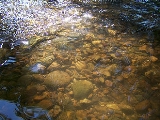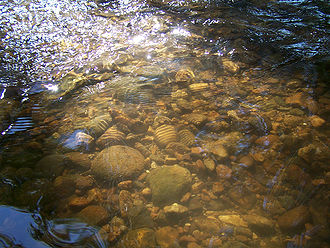
Stream bed
Encyclopedia

Stream
A stream is a body of water with a current, confined within a bed and stream banks. Depending on its locale or certain characteristics, a stream may be referred to as a branch, brook, beck, burn, creek, "crick", gill , kill, lick, rill, river, syke, bayou, rivulet, streamage, wash, run or...
, river
River
A river is a natural watercourse, usually freshwater, flowing towards an ocean, a lake, a sea, or another river. In a few cases, a river simply flows into the ground or dries up completely before reaching another body of water. Small rivers may also be called by several other names, including...
or creek; the physical confine of the normal water flow. The lateral confines or channel margins, during all but flood stage
Flood stage
Flood stage is the level at which the surface of a river, creek, or other body of water has risen to a sufficient level to cause damage or affects use of man-made structures...
, are known as the stream banks or river banks. In fact, a flood
Flood
A flood is an overflow of an expanse of water that submerges land. The EU Floods directive defines a flood as a temporary covering by water of land not normally covered by water...
occurs when a stream overflows its banks and flows onto its flood plain. As a general rule, the bed is that part of the channel
Stream channel
Stream channel is the physical confine of a stream consisting of a bed and stream banks.Stream channels exist in a variety of geometries. The stream channel development is controlled by both water and sediment movement. There is a difference between low gradient streams and high gradient streams...
, just at the "normal" water line and the banks are that part above the water line. However, because water flow varies, this differentiation is subject to local interpretation. Usually, the bed is kept clear of terrestrial vegetation
Vegetation
Vegetation is a general term for the plant life of a region; it refers to the ground cover provided by plants. It is a general term, without specific reference to particular taxa, life forms, structure, spatial extent, or any other specific botanical or geographic characteristics. It is broader...
, whereas the banks are subjected to water flow only during unusual or perhaps infrequent high water stages and therefore, might support vegetation some or much of the time.
The descriptive terms "right bank" and "left bank" are relative to an observer looking downstream
Current (stream)
A current, in a river or stream, is the flow of water influenced by gravity as the water moves downhill to reduce its potential energy. The current varies spatially as well as temporally within the stream, dependent upon the flow volume of water, stream gradient, and channel geometrics...
, in which the right bank is to the observer's right, and vice versa. A famous example of this is the naming of the two sides of the river Seine
Seine
The Seine is a -long river and an important commercial waterway within the Paris Basin in the north of France. It rises at Saint-Seine near Dijon in northeastern France in the Langres plateau, flowing through Paris and into the English Channel at Le Havre . It is navigable by ocean-going vessels...
in Paris.
The nature of any stream bed is always a function of the flow dynamics and the local geologic materials, influenced by that flow. With small streams in mesophytic
Mesophyte
Mesophytes are terrestrial plants which are adapted to neither a particularly dry nor particularly wet environment. An example of a mesophytic habitat would be a rural temperate meadow, which might contain Goldenrod, Clover, Oxeye Daisy, and Rosa multiflora.Mesophytes make up the largest ecological...
regions, the nature of the stream bed is strongly responsive to conditions of precipitation
Precipitation (meteorology)
In meteorology, precipitation In meteorology, precipitation In meteorology, precipitation (also known as one of the classes of hydrometeors, which are atmospheric water phenomena is any product of the condensation of atmospheric water vapor that falls under gravity. The main forms of precipitation...
runoff
Surface runoff
Surface runoff is the water flow that occurs when soil is infiltrated to full capacity and excess water from rain, meltwater, or other sources flows over the land. This is a major component of the water cycle. Runoff that occurs on surfaces before reaching a channel is also called a nonpoint source...
. Where natural conditions of either grassland
Grassland
Grasslands are areas where the vegetation is dominated by grasses and other herbaceous plants . However, sedge and rush families can also be found. Grasslands occur naturally on all continents except Antarctica...
or forest
Forest
A forest, also referred to as a wood or the woods, is an area with a high density of trees. As with cities, depending where you are in the world, what is considered a forest may vary significantly in size and have various classification according to how and what of the forest is composed...
ameliorate peak flows, stream beds are stable, possibly rich, with organic matter and exhibit minimal scour. These streams support a rich biota. Where conditions produce unnatural levels of runoff, such as occurs below roads, the stream beds will exhibit a greater amount of scour, often down to bedrock and banks may be undercut. This process greatly increases watershed erosion and results in thinner soils, upslope from the stream bed, as the channel adjusts to the increase in flow.
Beds are usually what would be left once a stream is no longer in existence; the beds are usually well preserved even if they get buried, because the walls and canyons made by the stream usually have hard walls, usually soft sand and debris fill the bed. Dry stream beds are also subject to becoming underground water pockets (buried stream beds only) and flooding by heavy rains and water rising from the ground and may sometimes be part of the rejuvenation of the stream.
See also
- Armor (hydrology)Armor (hydrology)Armor, in hydrology and geography is the association of surface pebbles, rocks or boulders with stream beds or beaches. Most commonly hydrological armor occurs naturally; however, a man-made form is usually called riprap, when shorelines or stream banks are fortified for erosion protection with...
- Benthic zoneBenthic zoneThe benthic zone is the ecological region at the lowest level of a body of water such as an ocean or a lake, including the sediment surface and some sub-surface layers. Organisms living in this zone are called benthos. They generally live in close relationship with the substrate bottom; many such...
- Hyporheic zone

